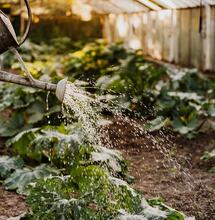How to use Clay Pebbles

Created from small pieces of clay that are processed at extremely high temperatures, expanded clay pebbles are very popular for use in hydroponic systems. They can also be used in Coco or soil, offering numerous benefits.
The extreme heat during manufacture creates lightweight, porous, irregular pebbles that help with water retention and water movement. The rough appearance and arrangement of the pebbles make a favourable environment. One that boosts growth improves drainage, oxygenate the root zone, encourage beneficial bacterial growth, and help with root binding for superior stability.
Clay pebbles are used as a sole substrate in recirculating hydroponic systems such as drip or flood and drain systems. They can also be used by soil and coco growers as a base layer to increase drainage. Also, they can be used as a top layer to reduce evaporation.
The Benefits of Using Clay Pebbles
Aeration:
Clay pebbles are light, absorbent, and bursting with oxygen, increasing the aeration of the plant's root system. The structural formation of the rocks is light. It has enough space to capture air and release it whenever the plants need it.
Water Retention and Drainage:
Clay pebbles have exceptional water retention and drainage abilities. They collect surplus water and store it in the micropores) for later use. They also move water more easily around the roots and drain it away more efficiently. Clay pebbles can be used solely as your growing medium, a base layer, or as an addition to Coco or soil.
Eco-Friendly
Clay pebbles are full of minerals and natural elements that help plants grow healthy and faster without impacting the environment. Clay is 100% organic, pH neutral and environment-friendly.
Reusable
You can wash and reuse clay pebbles. Their lifespan depends on how well you use and look after them. Remember never to let them dry out completely if you intend on reusing them.
Clay Pebbles- Top Tips
Rinse Before Use:
Preventing potential blockages or build up in your system reservoir. Rinsing removes dust and debris from the manufacturing process. Soak your pebbles for 6-24 hours with an air stone. An excellent general rule to stick to is to make sure a 3-inch radius of pebbles around your plants is always fully saturated.
Add Nutrients Before First use:
After rinsing, place the pebbles in a container and fill it with a nutrient solution with an EC below 0.4. Check with a ppm/EC meter, or use your base feed at 1/4 strength. This prepares the pebbles and infuses them with nutrients for the plants to take up from the very start.
Rinse pebbles regularly:
Clay pebbles are an "inert" medium that cannot provide nutrients to the plant alone. However, they do have a high CEC value, meaning that the clay can bind with and hold nutrients for longer. As a result, you may notice a whitish substance forming on your pebbles. This is a salt residue that could cause phytotoxicity. This is a condition that starves the plant of water or nutrients.
Regularly pull your plants from the system and rinse the pebbles thoroughly using fresh, pH-adjusted water. If you're not using pots, flush the entire system with pH-adjusted water. This will keep your things free of toxic salt buildup. Using a plant enzyme additive is an excellent solution to remove any buildup.
Water Retention
Crushing clay pebbles reduces the size of the macro-pores and increases water retention. Treat crushed pebbles like traditional potting mix. Do not crush them too finely if you are using a net pot, as they will pass through the net pot.



.png)
